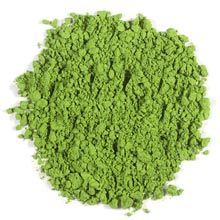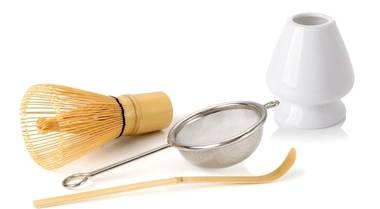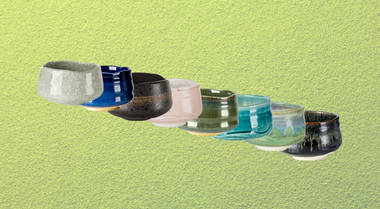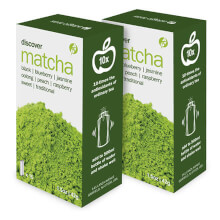Supplies to Make Matcha Tea Powder at Home
by Abby Morrison
October 15, 2019

Kettle
This one is obvious, but the first thing you'll need to make matcha is something to heat the water. At Adagio, we currently offer many different options, including the UtiliTEA Kettle (I've had one for years and love it), the VarieTEA Kettle, the VelociTEA Tea Maker, the Glass Water Kettle, the Handmade Copper Kettle, and our line of Glazed Iron Teapots. The first three are electric, with options to heat the tea to varying temperatures depending on the tea.
Cup
Another obvious choice, if you're going to enjoy your nice cup of matcha, from a mug, first you need the cup. Choose an old favorite, or if you're looking for something new, check out our ceramic cups, color-changing mug, tasting set, and infusers. Though many people enjoy matcha straight from the bowl. More on that later!
Matcha
The last of the obvious pieces of equipment you'll need, the matcha powder itself is the star of the show. At Adagio we offer eleven different flavors, available in various forms and quantities here.Storage
Given that all our teas come in resealable containers, this one is technically optional, but when matcha is so pretty, it's hard not to want to put it on display, or at least put it in a fancy container. My personal favorites are always the clear glass containers so you can see the natural green of the matcha (or whatever other tea you put in them), but seeing as you could get a grasshopper colored tin (or several other colors) too, it's really up to you!Now, on to the really specialized stuff.
Scoop
Matcha scoops are long thin bamboo spoons, used to ladle out the perfect amount of matcha into your strainer or cup. They have been used in traditional Japanese tea ceremonies for centuries, with ritualized steps that even go down to the specifics of how the scoop is used, placed, and cleaned.Strainer
Because matcha comes in a powder form, there is a tendency for it to clump up into little balls, similar to flour or powdered sugar. Given that making matcha involves incorporating all of the powder into the water however, your matcha will come out better if you break these clumps up before starting the process. To do this, you'll want to use a strainer to sift the matcha, similar to sifting flour for baking. We suggest using our matcha strainer, which is smaller than a traditional flour sifter, easy to clean, and perfectly sized to fit over your favorite cup or chawan bowl. Simply scoop your matcha into the strainer and lightly shake it or tap it against the bowl to sift the matcha through. If you do end up with larger clumps, use the scoop to break them up and push them through.
matcha accessories
Whisk
If you've ever seen anyone make matcha, this is likely the most distinctive piece of equipment other than the scoop. A matcha whisk is a bamboo whisk used to mix the matcha powder into the water. Similar to the scoop and bowls, they are an important piece of the traditional tea ceremony.Whisk stand
Whisk stands, as their name might suggest, are stands used for your whisk. Their benefits are several-fold. One, if you're making a cup for yourself, you aren't going to get matcha on your counter (like all teas, it can stain) while you transfer your matcha from bowl to cup. Second, if you're making multiple cups, you aren't going to get your whisk dirty in between stirrings. Third, you aren't going to have matcha run up the bristles like you would if you rest the whisk on its end. Fourth, you're going to protect the bristles and preserve your whisk for longer by not bending them against your counter, drawer, or other utensils. Lastly, of course, it also just looks nice. Making matcha, though simple, does have a fancy feel to it, and there's definitely a certain charm to being able to put your whisk on display when it's not in active use.
chawan, or matcha bowl
Bowl
Lastly, but certainly not least, you'll want a matcha bowl for mixing. Large enough to accommodate the whisk, they are specially designed for making matcha and can be used either just for mixing or for drinking in a pinch. Also known as matcha chawan, these large cups are part of the Japanese tea ceremony dating back centuries. Sculpted entirely by hand, each matcha bowl is a unique ceramic creation covered in designs inspired by local colors and landscapes. Currently, there are eight color options at Adagio, ranging from pale sages and pinks to vibrant blues, mellow greens, rich blacks, and earthy browns. I have the pine matcha bowl myself and adore it.
A few caveats
It's important to note that while these are the tools used in the traditional preparation of matcha, if you are just looking to dip a toe into these lush green waters, you do not need all of this equipment to start out. We offer simple instructions online for how to make matcha without any specialized equipment you wouldn't already need for other kinds of tea, as well as matcha sticks, which don't need any equipment at all other than a water bottle or thermos.That being said, if you want to dive all in, these are the tools you'll need to make matcha the traditional way, as we'll be highlighting in our next post in this series.